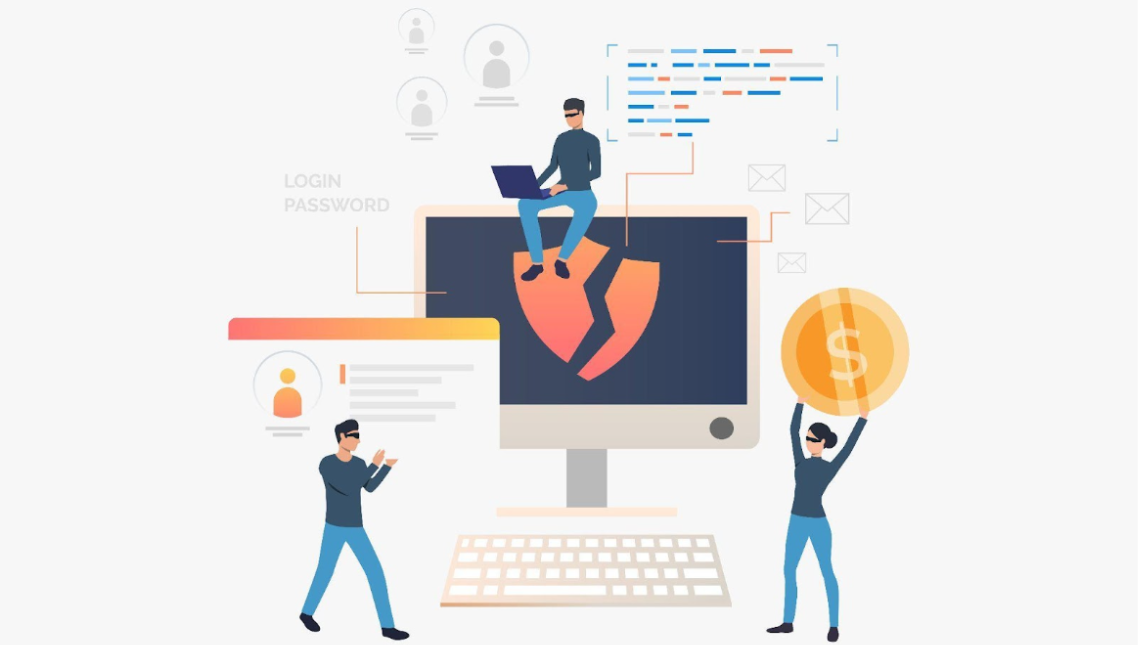WGU D340 OA Study Guide - 2025 | Mastering Cyber Defense📖
Welcome to the world of cybersecurity, where every day brings new challenges and exciting opportunities to become a network superhero. Ever wondered how companies handle cyberattacks or stay ahead of hackers? In this article, we’ll explore three key areas of cyber defense:
- Incident Response and Handling: A Step-by-Step Guide: Incident response involves identifying, containing, eradicating, and recovering from security incidents. This guide outlines a structured approach to handling cyber threats effectively.
- Threat Intelligence: Understanding and Using It to Protect Networks: Threat intelligence helps organizations detect and prevent cyberattacks by analyzing data on emerging threats, attack patterns, and vulnerabilities.
- Vulnerability Management: Finding and Fixing Weaknesses in Your Network: Vulnerability management is a continuous process of identifying, assessing, and remediating security weaknesses to reduce the risk of exploitation.
Our instructions will explain each step plainly so you obtain the capabilities to confront any cyber security issue. The completion of these lessons will put you in an advantageous position to understand WGU D340 fundamentals which will advance your cybersecurity career. Ready to dive in? Let’s get started!
How to Use This Guide for the WGU D340 OA Exam?📝
The D340 Cyber Defense and Countermeasures OA exam at WGU evaluates your understanding of incident response, network defense strategies, and vulnerability management. This guide simplifies the key concepts of incident response and handling, threat intelligence (understanding and using it to protect networks), and vulnerability management (finding and fixing weaknesses in your network) to help you grasp the topics tested in the exam.
We also provide exam-style questions and practical applications to ensure you’re fully prepared for the questions on the WGU D340 OA exam.

Incident Response and Handling: A Step-by-Step Guide For D340 OA📝
The primary objective following a cyberattack is to control the incident effectively while reducing resulting damage and stopping new incidents from occurring. The process of incident response (IR) takes effect at this moment. It serves as the definition of incident response. Organizations apply this organized process as their security breach and cyberattack management methodology. A threat management framework exists to detect hazards identically while confining them and then taking out threats before conducting post-incident recovery activities along with data collection to optimize defensive capabilities.
This document presents a breakdown of incident response practices to help beginners understand the execution process of security incident management. All security incident handling processes must be built from basic incident management steps.
1. Preparation: Setting Up for Success
The first phase in incident response is preparation. This stage is about laying the groundwork for how to respond to a cyberattack. Imagine this step as setting up the right tools and creating a plan before any incidents happen.
Key Actions:
- Develop clear policies and procedures for responding to cyber threats. These will be followed in the event of an attack.
- Create an Incident Response Plan (IRP) that outlines what needs to be done, who will do it, and in what order.
- Train employees regularly so they know how to spot suspicious activity and what steps to take if they detect a potential threat.
- Establish a Computer Incident Response Team (CIRT), which is a group of dedicated professionals who will handle the attack when it happens.
The preparation phase is crucial for ensuring that everyone is ready to react swiftly and effectively. Without a proper plan in place, even a small attack could turn into a disaster.
2. Identification: Recognizing the Threat
After an attack happens organizations must move to identification activities. Identification needs to determine whether an actual security incident has taken place. Security detection tools comprising IDS systems alongside firewalls and SIEM systems serve to detect suspicious incidents by triggering alarms.
Key Actions:
- Gather information from the system to identify any unusual activities. This might include checking logs, monitoring network traffic, or investigating failed login attempts.
- Use known indicators of compromise (IOCs) to recognize the type of threat. These are signs that a system has been compromised, like strange network traffic or malware detection alerts.
- Once the incident is confirmed, it’s essential to assess the severity. This will guide the urgency and the steps to take next.
Identifying the threat quickly is important for deciding how severe the incident is and how to proceed.
3. Containment: Limiting the Damage
Next, after threat detection comes threat containment as the following stage of response. The containment process requires you to remove systems affected by the cyberattack to stop the spread of the breach. The safety measure functions as a protective blockade that prevents fire damage from spreading beyond its initial area.
Key Actions:
- Disconnect affected systems from the network. If a computer has been compromised, it should be isolated to prevent further damage.
- Use tools that help manage security incidents to monitor the attack’s progression and to stop it from getting worse.
- At this stage, you may also decide to disable certain services temporarily if they are contributing to the attack.
Containment is essential for protecting the rest of the network while the attack is being dealt with.
4. Eradication: Removing the Threat
The main step after containment involves the complete removal of destructive components that initiated the security breach. Organizations erase malware programs and eliminate access created by the attacker as part of the eradication procedure.
Key Actions:
- Identify and remove any malicious software, files, or tools that the attacker might have left behind.
- Repair any vulnerabilities that were exploited by the attack.
- If possible, replace the compromised machines to ensure that nothing harmful remains.
Eradication ensures that the threat is fully neutralized and that the organization can begin recovering safely.
5. Recovery: Bringing Systems Back Online
An organization can initiate recovery procedures following the complete removal of the threatening elements. After restoration, the goal is to secure the affected systems to a state where they operate normally before network reintroduction takes place.
Key Actions:
- Restore data from backups and reconfigure systems to bring them back online.
- Continuously monitor systems to ensure the attacker hasn’t left any backdoors for future access.
- Test the systems to make sure everything is functioning properly and securely.
Recovery is a critical phase because it restores business operations while ensuring that systems are fully secure.
6. Lessons Learned: Analyzing the Incident
Once the attack is over, the final phase is lessons learned. This phase is about looking back at the incident to determine what went well and what could have been done better. The purpose is to improve for the future and update the incident response plan accordingly.
Key Actions:
- Analyze how the attack occurred, what weaknesses were exploited, and how the response could be improved.
- Update security measures, such as adding new protections or improving employee training.
- Document the incident thoroughly so that it can be referenced when planning for future attacks.
By learning from each incident, organizations can better prepare for future attacks and continuously improve their security posture.
To stay ahead of cyber threats, understanding and using threat intelligence is crucial for protecting networks, a key concept covered in WGU D340 to equip you with the knowledge needed to defend against evolving dangers.
Threat Intelligence: Understanding and Using It to Protect Networks For D340 OA📝
The evolving digital environment features sophisticated cyber threats which make them more challenging to detect. The adoption of threat intelligence provides an effective solution to current risks. But what exactly is it? The process of threat intelligence requires organizations to collect and analyze security threats data which helps prevent network and system vulnerabilities in advance. Organizations become better at defending their infrastructure when they learn about cybercriminal behavior through the analysis of their TTPs which allows them to reply to attacks with greater speed.
1. What is Threat Intelligence?
The essential purpose of threat intelligence is to map current cyber threats in order to maintain a strategic position over adversaries. You need to collect signs indicating potential security concerns because such warnings allow you to avoid critical dangers. Security experts use this approach to find developing threats while grasping surrounding conditions which enables them to construct adequate protective measures.
Why is Threat Intelligence Important?
- It helps you recognize patterns and predict potential attacks.
- It allows for informed decisions on how to strengthen network defenses.
- It enhances collaboration, as threat data can be shared across security teams to improve overall protection.
When effectively used, threat intelligence empowers organizations to prevent attacks or respond swiftly if one occurs. It’s about transforming raw data into actionable insights that help secure your network.
2. The Threat Intelligence Lifecycle
The process of gathering and utilizing threat intelligence isn’t random; it follows a structured lifecycle. Let’s break it down step by step:
- Scoping Requirements:
This is the starting point, where you define what kind of threats you need to focus on based on your business needs. It involves setting clear objectives so that the data gathered is relevant to your organization’s security posture. - Threat Intelligence Collection:
Raw data is obtained through various sources that include open-source intelligence (OSINT) in addition to security alerts and threat feeds. Dark web markets and cybersecurity platforms with forums serve as sources that reveal upcoming threats to users. To achieve a complete risk understanding organizations need to obtain intelligence through different information sources. - Threat Intelligence Processing:
Once collected, this data is structured and organized so it’s easier to analyze. The goal is to remove irrelevant data and focus on the most critical threat indicators. This helps streamline the analysis phase. - Threat Intelligence Analysis:
Now, the real work begins. Proposed data undergoes transformation to generate valuable insights in the analysis stage. Adversary profiling together with pattern identification and tactic understanding form the core of this step. Examine the logic of threatening forces to understand their potential implications against the organization in this essential step. - Threat Intelligence Dissemination:
Once analyzed, the finished intelligence is shared with key business units or individuals. This could be in the form of alerts, briefings, or written reports, ensuring that everyone in the organization is aware of the current threat landscape. - Feedback:
The last part of the cycle involves taking feedback from the intelligence users. This helps refine the process and improve future collection and analysis, ensuring that threat intelligence remains relevant and actionable.
3. Types of Threat Intelligence
Threat intelligence is not a one-size-fits-all approach. There are different types, each providing a unique perspective on security threats:
- Strategic Intelligence:
This high-level intelligence focuses on long-term risks and trends. It’s most useful for decision-makers and executives who need to understand emerging threats and plan accordingly. - Tactical Intelligence:
This intelligence provides in-depth details on specific attack methods. It helps IT security teams understand the techniques cybercriminals use, so they can better protect their systems. - Operational Intelligence:
This type of intelligence is more timely and focused on specific, imminent threats. It gives actionable warnings about attacks that are currently underway or about to happen. - Technical Intelligence:
Derived from internal sources, technical intelligence includes details like malware signatures, IP addresses, and other technical indicators of compromise (IOCs). It helps identify specific threats affecting the network.
4. Key Components and Tools for Threat Intelligence
To gather and analyze threat intelligence effectively, various tools and platforms are used. One example is MISP (Malware Information Sharing Platform), an open-source platform for sharing and analyzing threat data. Here’s how it helps:
- Data Ingestion: Import threat intelligence from different feeds and internal sources.
- Data Structuring: Organize data into structured formats like Events and Attributes (IOCs) for better analysis.
- Information Sharing: Share intelligence with trusted partners to improve collaborative defense efforts.
- Customization & Integration: Tailor MISP to specific needs and integrate it with security tools for automation.
Platforms like MISP help security teams automate the process of ingesting, analyzing, and sharing threat data, making the entire threat intelligence lifecycle more efficient.
5. Practical Applications of Threat Intelligence
Threat intelligence is not just theoretical; it has real-world applications that make a difference in network defense. Here are a few ways organizations can use threat intelligence to protect themselves:
- Automating Firewall Rules: By ingesting IOCs, organizations can automatically update firewall rules to block known threats.
- Vulnerability Management: By comparing CVE (Common Vulnerabilities and Exposures) data with the organization’s applications, they can prioritize which vulnerabilities to fix first.
- Incident Detection: Using threat intelligence to analyze logs from illicit channels helps identify infected devices and reduce security risks.
To effectively safeguard your network, vulnerability management plays a pivotal role in identifying and fixing weaknesses, a crucial topic in WGU D340 to ensure your systems remain secure against evolving threats.
Tired of reading blog articles?
Let’s Watch Our Free WGU D340 Practice Questions Video Below!

Vulnerability Management: Finding and Fixing Weaknesses in Your Network For D340 OA📝
A network of any organization contains multiple weak points which cyber attackers can use to initiate attacks. Network vulnerabilities become manageable through the assessment and fixing process which safeguards your system from cyber attacks. This explanation details the operation of vulnerability management together with its essential role in securing systems.
1. What is Vulnerability Management?
Network security professionals use continuous identification followed by remediation of both their system weaknesses and their network vulnerabilities. You should inspect your house for entry points that burglars may exploit by checking all locked doors and windows. Detecting network weaknesses at an early stage allows proper prevention of attacks on your systems.
The goal is to ensure all systems—hardware, software, and data—are secure. Vulnerability management involves scanning for vulnerabilities, evaluating their severity, and taking corrective actions.
2. Vulnerability Assessment: A Step-by-Step Guide
A vulnerability assessment helps find potential weaknesses in your network. The steps in a typical vulnerability assessment include:
- Define Objectives and Scope:
First, you need to define what will be assessed, whether it’s networks, applications, or systems. This ensures that you focus on the most critical components of your infrastructure. - Identify and Document Assets:
Create a list of all assets (hardware, software, and data) and prioritize those most crucial to the business. This serves as a baseline to understand what needs protection. - Vulnerability Scanning:
Now, use scanning tools like Nessus or Qualys to automate the process. These tools help identify vulnerabilities in systems, applications, or network components. - Analyze the Results:
After scanning, analyze the findings and assign risk ratings to each vulnerability. This helps you prioritize which vulnerabilities should be addressed first based on their severity. - Prioritize Vulnerabilities:
Not all vulnerabilities are equally critical. Focus on the most urgent ones—those that could cause the most damage or are already being exploited. - Remediation and Mitigation Plan:
Develop a plan to fix vulnerabilities. After addressing them, rescan to verify that the issues have been resolved.
3. Types of Vulnerability Assessments
Different types of vulnerability assessments target specific areas:
- Host Scans: Focus on vulnerabilities in servers, workstations, and network hosts.
- Network Scans: Examine wired and wireless networks for access points and configuration weaknesses.
- Application Scans: Test websites, web apps, and source code to identify potential weaknesses.
- Database Scans: Look for vulnerabilities in database systems that could lead to breaches.
Each scan focuses on different parts of the network, helping identify a wide range of vulnerabilities.
4. Tools for Vulnerability Management
There are various tools to assist with vulnerability assessments:
- Network Scanners: Identify weak points like spoofed packets or stray IP addresses.
- CMS Web Scanners: Scan content management systems like WordPress and Drupal.
- Port Scanners: Look for vulnerabilities across thousands of ports.
- Protocol Scanners: Test network protocols for weaknesses.
- Web Application Scanners: Simulate attack patterns to test web application security.
These tools automate scanning, making it easier to detect vulnerabilities across your network.
5. Integrating Vulnerability Management into Cyber Defense
Every organization must integrate vulnerability management into its fundamental cybersecurity plan. Your defense system becomes stronger when you practice scheduled vulnerability detection followed by remediation activities thus adding value to threat intelligence and incident response processes. The implementation of preventive measures through this approach minimizes cyber attack risks.
Vulnerability management also informs incident response and disaster recovery plans, ensuring that the organization can quickly recover if an attack happens.
6. Risk Management in Vulnerability Management
Risk management is a key component of vulnerability management. It involves assessing vulnerabilities based on their potential impact. Here’s how to approach risk management:
- Identify Assets: Understand what’s most valuable to your organization.
- Assess Threats and Vulnerabilities: Identify threats and assess weaknesses in the system.
- Assess Risk: Evaluate the damage that vulnerabilities could cause.
- Mitigate Risk: Take actions to reduce or eliminate the risk associated with vulnerabilities.
By integrating risk management with vulnerability management, organizations can focus on addressing the most critical vulnerabilities first.
By regularly identifying and fixing vulnerabilities, vulnerability management helps safeguard networks from cyberattacks, a key concept you’ll master in WGU D340 to build a strong cybersecurity defense.

Your Cyber Defense Toolkit: Master These Skills for Success in WGU D340 OA📄
Well done! You have concluded your exploration of incident response analytic techniques and threat intelligence combined with vulnerability management methods that serve as primary cybersecurity fundamentals. The essential skills presented throughout this content provide the foundation knowledge required for the WGU D340 program and additional cybersecurity practice.
Before undertaking the WGU D340 OA final exam review these fundamental concepts repeatedly. For your success, you must understand these concepts deeply before real-world application of them. Information acquired at this point will help you develop robust defense mechanisms that support your protection against sophisticated cyber attacks.
Keep studying, stay sharp, and remember—these skills will serve you well in both your OA and your cybersecurity career. Good luck in your journey through WGU D340—you’ve got this!






